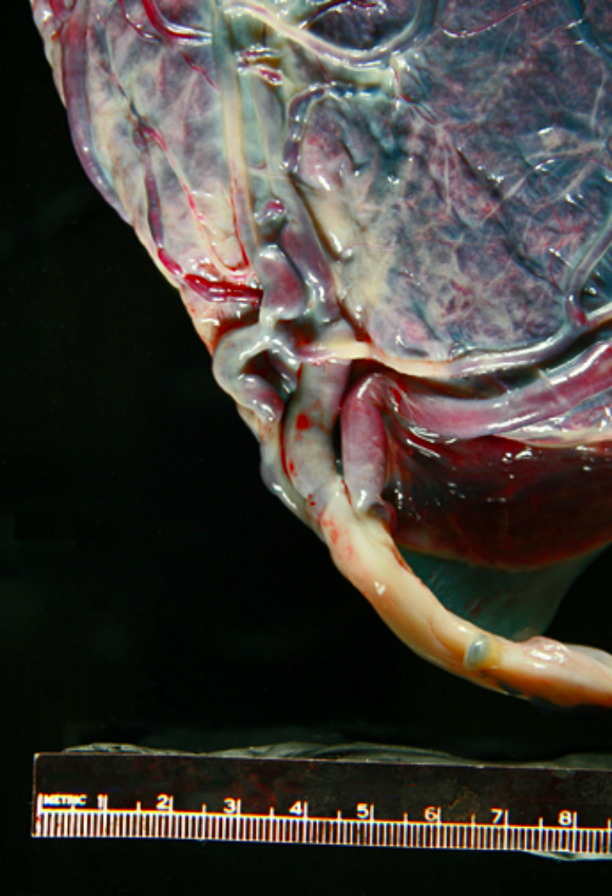Marginal cord insertion
What is marginal cord insertion?
The point where the umbilical cord enters the placenta is called the cord insertion site. Normally, the umbilical cord should enter the placenta from the center. If the cord enters the placenta from the edge, this condition is called "marginal cord insertion" [1].
Because the shape of the placenta and umbilical cord resembles a badminton racket, it is also called "battledore placenta."


Image source: [2]
What causes marginal cord insertion?
Main cause: Uneven development of uterine decidua
Currently, it is believed that marginal cord insertion is mainly caused by uneven development of the uterine decidua (the endometrium after pregnancy) in the early stages.
If we compare the fetus to a small seed, the uterine decidua is like the soil. The seed needs to take root in the soil through the placenta to absorb nutrients. If some parts of the soil are fertile while others are barren, the blood supply to different parts of the placenta may become uneven, leading to a deviation in the cord insertion site.
The incidence of marginal cord insertion is about 6%.
Several factors increase the likelihood of marginal cord insertion
Generally, pregnant women who have had a previous cesarean section, conceived through IVF, or are carrying multiple fetuses are more likely to experience marginal cord insertion.
Additionally, if the placenta is low-lying or has an abnormal shape (e.g., lobed placenta), marginal cord insertion is also more likely to occur.
How is marginal cord insertion treated?
No treatment is required
If marginal cord insertion is detected during pregnancy via ultrasound, there is no need to panic. This condition does not indicate a problem with the fetus, and no treatment is currently required.
Moreover, the position of the placenta and umbilical cord cannot be artificially adjusted.
Regular ultrasound monitoring of fetal growth
When an abnormal cord insertion is found, the ultrasound technician will carefully examine it. If the cord insertion site is indeed at the edge of the placenta, it will be recorded in the ultrasound report.
Based on the results, the doctor may recommend regular monitoring of umbilical cord blood flow and fetal growth.
What symptoms might pregnant women with marginal cord insertion experience?
Most women have no discomfort
Most pregnant women with marginal cord insertion do not experience any discomfort, and the condition is often detected during routine ultrasound examinations.
Generally, if the ultrasound shows the cord insertion site is ≤ 2 cm from the placental edge, the doctor may note possible marginal cord insertion or battledore placenta. However, some cases are only discovered after delivery during placental examination.
May lead to smaller fetal size
Marginal cord insertion may result in lower fetal weight, which is usually detected via ultrasound. However, it typically does not cause severe fetal growth restriction, so parents need not worry excessively.
What should pregnant women do if diagnosed with marginal cord insertion?
Stay calm and attend regular prenatal checkups
If marginal cord insertion is detected, pregnant women should not panic but should follow the doctor's advice and undergo regular ultrasounds to monitor fetal growth.
Ensure adequate nutrition
Since marginal cord insertion may lead to lower fetal weight, maintaining proper nutrition is especially important.
Generally, during the second and third trimesters, increasing intake of high-quality protein—such as dairy, fish, poultry, eggs, and lean meat—can meet the body's needs for protein, vitamin A, calcium, and iron. Eating fish 2–3 times a week can provide n-3 long-chain polyunsaturated fatty acids.
Exercise appropriately
Marginal cord insertion does not affect normal exercise. Unless there are complications like vaginal bleeding, threatened preterm labor, placenta previa, fetal growth restriction, severe cardiopulmonary disease, or uncontrolled hypertension or diabetes, pregnant women are advised to exercise at least 5 days a week for about 30 minutes per session.
Moderate-intensity aerobic activities, such as yoga or swimming, are beneficial for both mother and baby.